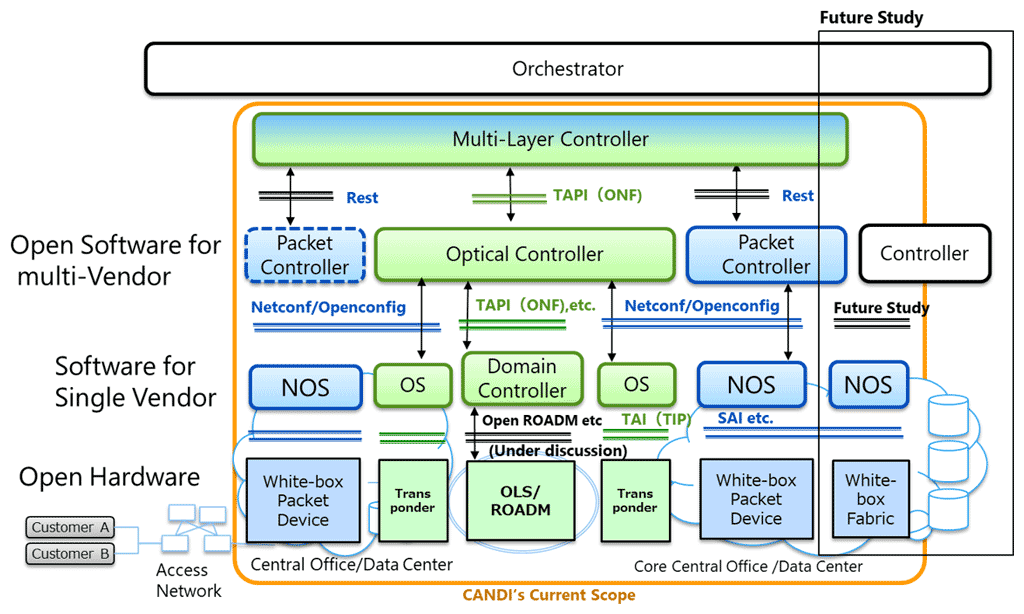Microsoft ends support for Internet Explorer on June 16, 2022.
We recommend using one of the browsers listed below.
- Microsoft Edge(Latest version)
- Mozilla Firefox(Latest version)
- Google Chrome(Latest version)
- Apple Safari(Latest version)
Please contact your browser provider for download and installation instructions.
October 16, 2019
NTT
Telefónica
NTT and Telefónica start PoC on Open Optical and Packet Transport technologies within Telecom Infra Project
- The first proof of concept(PoC) was carried out at Converged Architectures for Network Disaggregation & Integration(CANDI) sub-group which is part of the Open Optical and Packet Transport Project Group (OOPT) within Telecom Infra Project (TIP,*1) covering both open packet and optical transport technologies
- NTT contributes to the first PoC with its open source software: Multi-Service Fabric (MSF,*2) and Beluganos(*3)
The Hague, The Netherlands -- October 16, 2019 -- Nippon Telegraph and Telephone Corporation (NTT; Headquartered in Chiyoda-ku, Tokyo, Japan; President and CEO: Jun Sawada) and Telefónica announced that they have conducted a successful PoC on Open Optical and Packet transport technologies at the SDN NFV World Congress 2019 in The Hague.
The goal is to implement open and commoditized networks to achieve wide scale economy for some components of the CANDI architecture and create an open market for disaggregated elements, both IP and optical.
To achieve this goal, NTT and Telefónica created the CANDI sub-group under the framework of TIP's OOPT in October 2018. In 2019, Orange, Telia Company and the pan-European research network operator GÉANT joined CANDI. Only one year after the creation of the working group, the first collaboration PoC was completed in Madrid.
With this PoC, the team succeeded in building a converged network with a packet technology controlling telecommunication traffic and an optical technology transmitting data long distance, following the required architecture, open technology and open interface that are promoted by CANDI(Figure1).
 Figure1. TIP CANDI's current architecture
Figure1. TIP CANDI's current architecture
To develop the PoC, Telefónica provided a multi-layer controller based on open standard interfaces with both the packet controller and optical controllers, and NTT provided an IP SDN Controller (MSF) and Network Operating System(Network OS,*4) Beluganos as the reference model of the architecture and open interface(Beluganos). Beluganos controls the OpenNSL as an open interface of packet transform chip of a white-box switch and also provides Netconf/Openconfig, which is becoming the de-facto open interface for remote-controlling packet devices. MSF succeeded in controlling three different NOSs on white-box switches and controlling the open interface that is Netconf/Openconfig for Beluganos(Figure2).
 FFigure.2 1st PoC structure
FFigure.2 1st PoC structure
This PoC is supported by Edgecore Networks, ADVA, IP Infusion and Infinera, as TIP members. Open community, ODTN in Open Network Foundation(ONF,ODTN,*5) and the EU funded project Metro-Haul provided implementation and support in the field of optical disaggregation.
Through this PoC, NTT and Telefónica have started providing the feasibility of use cases required by the operators in CANDI. At the same time, they started a community to clarify the issues to be addressed for obtaining all the functions required by the use cases including scalability and operational issues.
NTT and Telefónica will continue to contribute to conducting enhanced PoC twice a year in CANDI to prove such feasibility and find the issues for developing the technology required to confirm the feasibility of operators' use-cases. By maximizing the advantage of disaggregation technology and by introducing latest technology much earlier, NTT and Telefónica will contribute to avoiding vendor lock-in and enabling telecommunication networks by which people can use much more varied services faster.
- NTT's MSF and Beluganos development history -
NTT started the MSF project in 2014 to promote the use of open hardware provided by such communities as the OCP and leading to disaggregation between software and hardware in packet transport equipment and the network architecture and developing its system. This project is enhancing service reliability and the flexibility of service development, as required by telecom operators. Since 2016, NTT has also started the development of in-house software, "Beluganos", which is a Network OS using an open interface controlling packet transmission chip in a white-box switch to activate the functions that are implemented by vendors(*6).
NTT has been disclosing MSF and Beluganos as Open Source Software to accelerate the development of open technology in the packet transport field and implementation of carriers' required features by multiple vendors to avoid vendor lock-in since 2017. This year, NTT contributed to and succeeded in PoC through collaboration PoC (*7) with Taiwan's largest carrier, Chunghwa Telecom by using the OSS.
*1Telecom Infra Project
The Telecom Infra Project (TIP) is a collaborative telecom community. Launched in February 2016, TIP started with the goal of accelerating the pace of innovation in the telecom industry.
(Reference: TIP web site: https://telecominfraproject.com/
*2Multi-Service Fabric (MSF)
Open SDN Controller provided by NTT, https://github.com/multi-service-fabric
*3Beluganos
Open Network OS provided by NTT, https://github.com/beluganos
*4Network OS
Network Operating System. Operating system for a network device such as a router, switch or firewall.
*5ONF, ODTN
ONF: An Operator Led Consortium, Transforming Networks into Agile Platforms for Service Delivery.
https://www.opennetworking.org/
ODTN: Open Disaggregated Transport Network
Under ONF. Aims to drive innovation and cost reduction in optical networks by delivering an open source platform, based on open APIs, software defined approaches and component disaggregation for running multi-vendor optical transport networks, starting with point-to-point, data center interconnect solution.
*6First output of Beluganos: Achieving Tbps-level transport functions with white-box switching on virtual networks
NTT's press release, https://www.ntt.co.jp/news2016/1609e/160928b.html
*7Japan-Taiwan Joint Experiment
NTT's press release, https://www.ntt.co.jp/news2017/1712e/171212a.html
Press Contact:
Nippon Telegraph and Telephone Corporation
Information Network Laboratory Group
Public Relations, Planning Department
Email: inlg-pr-pb-ml@hco.ntt.co.jp
Telefónica
S.A. Directorate of Corporate Communications.
Ronda de la Comunicación, s/n. 28050 Madrid.
Phone number: +34 91 482 38 00
Email: prensatelefonica@telefonica.com
http://saladeprensa.telefonica.com
http://saladeprensa.telefonica.com
Information is current as of the date of issue of the individual press release.
Please be advised that information may be outdated after that point.
NTT STORY
WEB media that thinks about the future with NTT










